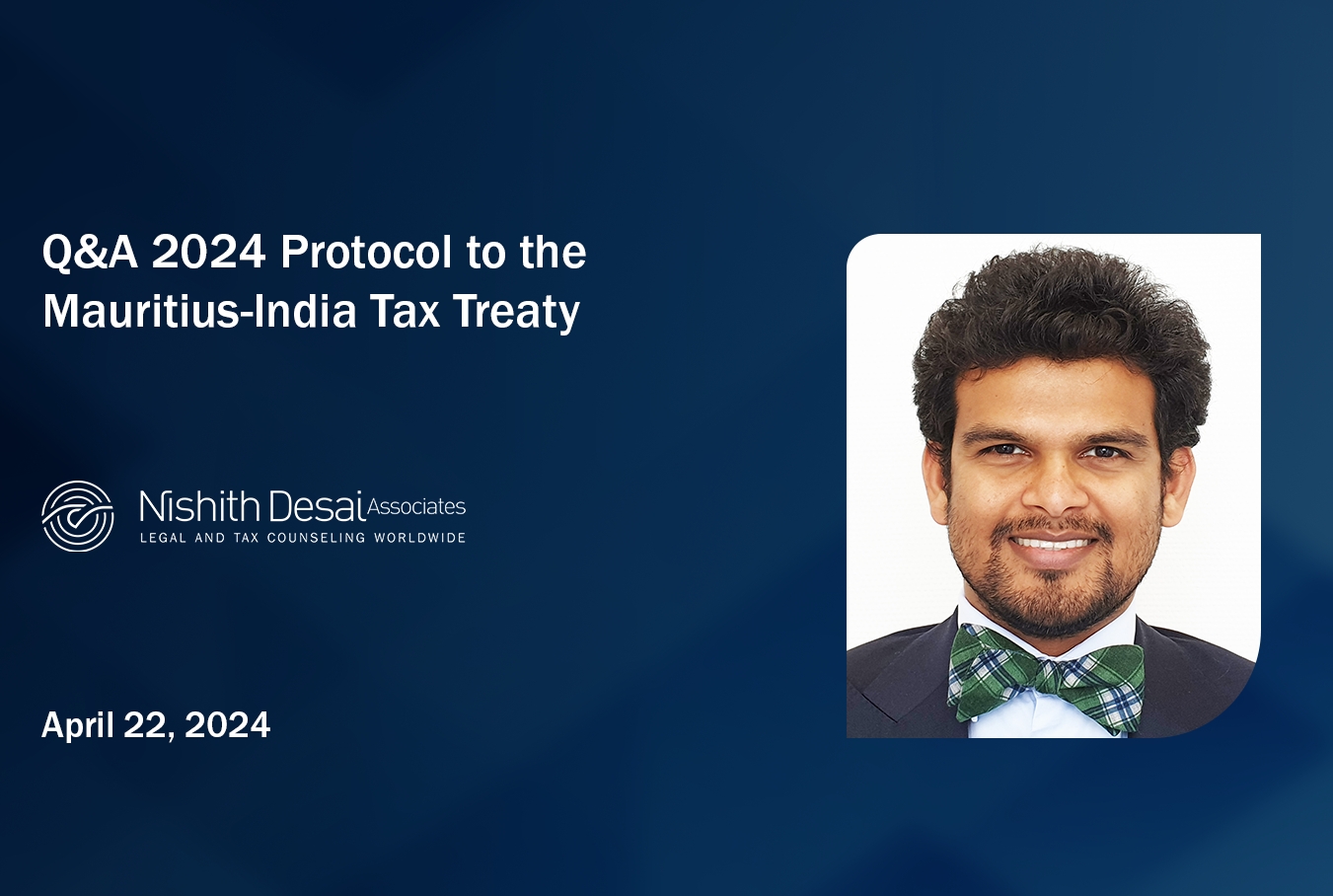Technology Law Analysis: Cross-Border Unified Payments Interface (UPI) Transactions: Connecting India with The World
Posted by By nishithadmin at 23 June, at 18 : 53 PM Print
Warning: count(): Parameter must be an array or an object that implements Countable in /web/qlc/nishith.tv/htdocs/wp-content/themes/Video/single_blog.php on line 46
Warning: count(): Parameter must be an array or an object that implements Countable in /web/qlc/nishith.tv/htdocs/wp-content/themes/Video/single_blog.php on line 52
CROSS-BORDER UNIFIED PAYMENTS INTERFACE (UPI) TRANSACTIONS: CONNECTING INDIA WITH THE WORLD
INTRODUCTION
India has risen as the topmost country for digital payment transactions in recent years. Last year, India recorded more digital payment transactions than those in the US, China and Europe combined.1 This is thanks to the Unified Payments Interface (‘UPI’) introduced by National Payments Corporation of India (‘NPCI’) about seven years ago on April 11, 2016. Every month, the number of UPI transactions continue to surpass those of the previous month. According to the NPCI, for the month of May 2023, the total number of monthly UPI transactions reached a record 9.4 billion with the transaction value of record INR 14.89 trillion (about USD 181 billion).2
India’s rise as the global leader in digital payments is attributable to its robust technological infrastructure and timely regulatory interventions. As UPI enables instant mobile-to-mobile payments at practically no cost, millions of people have adopted it as the primary mode of payments. Every UPI transaction is required to use two-factor authentication, a passcode or PIN for accessing any UPI app as well to confirm the transaction. Thus, UPI has become a highly secure payment mechanism earning trust among its users.
Recently, India has undertaken various initiatives to extend the reach of UPI beyond its borders and make it a truly global payment system. We have described below the Indian and country-wise initiatives on cross-border and international UPI payment facilities.
INDIA INITIATIVES
NPCI is a non-profit umbrella organisation set up by the Reserve Bank of India (‘RBI’) that operates retail payments and settlement systems in India. Since 2020,3 NPCI has taken several steps to enable the use of UPI globally for international peer-to-peer and merchant payments.
1. UPI Global
The NPCI mandated that all stakeholders – i.e. member banks, third party application providers and other payment providers – provide UPI Global by December 31, 2021.4 While this timeline was extended to September 30, 2022 to accommodate additional members that had not implemented the feature at the issuer and UPI app level5, no further extension has been granted by NPCI. PhonePe was the first Indian fintech to support cross-border UPI payments. Users of PhonePe can pay through their Indian bank accounts to merchants at merchant outlets or points-of-sale in the UAE, Singapore, Mauritius, Nepal, and Bhutan.6 Paytm has also announced that it will launch support for UPI Global payments.7
2. UPI for Non-Resident Indians
As per NPCI’s circular dated January 10, 20238, non-resident accounts like Non-Resident External (NRE) and Non-Resident Ordinary (NRO) Accounts with international mobile numbers are allowed to be on-boarded and transact using UPI. To begin with, mobile numbers from the following ten countries would be permitted – United States, United Kingdom, Singapore, Canada, Australia, Oman, Qatar, UAE, Saudi Arabia and Hong Kong. The responsibility of adherence to foreign exchange laws and RBI guidelines is on member banks, and anti-money laundering compliance is the responsibility of the remitter and beneficiary banks.
3. UPI for Foreign Travellers in India
The RBI Master Directions (‘PPI MD’) on Prepaid Payment Instruments (‘PPIs’) were amended in February 2023.9 laying down provisions for issuance of PPIs to foreign nationals and NRIs visiting India (together, ‘Travellers’). The PPI MD states that INR denominated full-KYC PPIs can be granted to Travellers, beginning with those travelling to India from G20 countries. Inbound travellers to India can avail UPI facilities through PPIs issued to them. To begin with, this facility has been offered to inbound travellers from G20 countries for merchant payments at select international airports — New Delhi, Mumbai and Bengaluru airports.10 Currently, ICICI Bank, IDFC First Bank and two non-bank issuers, Pine Labs Private Limited and Transcorp International Limited, issue UPI-linked wallets. In February 2023, EbixCash was the first entity to provide UPI services to the travellers as part of a pilot testing phase.11
Traveller PPIs are issued in the form of e-wallets linked to UPI, after physical verification of the Travellers’ passports and visas. Traveller PPIs can only be loaded/reloaded against the receipt of foreign currency in cash or through any other payment instrument, and the Traveller PPIs can only be used for merchant payments. The amount outstanding on the Traveller PPI cannot be more than INR 200,000 at any given time.
BILATERAL INITIATIVES
Several digital economies such as the UK, Singapore and UAE have partnered with India’s NPCI, through the latter’s wholly owned subsidiary, NPCI International Payments Limited (‘NIPL’). The partnerships propose to offer seamless cross-border payments, allowing Indians to use UPI in Singapore for real-time peer-to-peer and merchant transactions, and in the UK and UAE for real-time peer-to-merchant transactions.
1. Singapore
Singapore has been actively promoting its Payments Roadmap that covers initiatives such as common QR codes for accepting payments, unified points of sale, and PayNow.12
The RBI and the Monetary Authority of Singapore announced in September 2021 that they would link their fast payment systems i.e., UPI and PayNow respectively.13 Chia Ling Koh, Managing Director at Osborne Clarke Singapore, remarks: “UPI – PayNow is currently offered by DBS and non-bank payment institution Liquid Group. The Monetary Authority of Singapore has been issuing non-bank payment institution licences under the relatively new Payments Services Act. Without a doubt, the payments services market is getting competitive in Singapore.”
The UPI – PayNow linkage should enable fund transfers between users in India and users in Singapore. The transfers from users in India to those in Singapore can be done using mobile phone numbers, and from Singapore to India using UPI virtual payment addresses. Further, Indian users visiting or living in Singapore can make payments to merchants in Singapore using their bank UPI apps.14
Peer-to-peer transactions
The UPI – PayNow linkage was operationalised in February 2023.15 The account holders of participating banks and financial institutions in Singapore and India can undertake cross-border remittance transactions via UPI and PayNow. As per the RBI FAQs on the UPI-PayNow linkage,16 six Indian banks17 are currently enabled for receiving remittances through the linkage, and four Indian banks18 are currently enabled to send the remittances. The FAQs list the apps and platforms offered19 by the above-mentioned banks that can be used as long as a user’s UPI ID is registered with the bank. There are two participating entities from Singapore20 for receiving and sending remittances.
A daily transaction limit of INR 60,000 (about SGD 1,000) is applicable, and presently, only peer-to-peer remittances for the purposes of maintenance of relatives abroad & gifts are allowed. The RBI’s Liberalised Remittance Scheme (‘LRS’) limit of USD 250,000 per financial year per individual will be applicable. P2M transactions have not been enabled via on the linkage. The linkage allows real time transactions, similar to domestic UPI transactions.
Users should be able to commence using this feature when the participating banks roll-out an update in their respective UPI apps. As of June 2023, we were unable to locate the payment and receiving feature on certain listed apps.
Peer-to-merchant transactions
For peer-to-merchant transactions, UPI is accepted in Singapore by select merchants via BHIM, the mobile payment app developed by NPCI based on the underlying UPI infrastructure. BHIM is linked to PayNow, and Indian users in Singapore can pay using BHIM UPI by scanning QR codes at select merchants in Singapore. The UPI feature on apps from the following banks can be used by Indians for cross-border merchant payments using PayNow: City Union Bank, UCO Bank, Bank of Baroda and Punjab & Sindh Bank. At the time of payment, the BHIM app will automatically convert and display the amount from Singapore Dollars to Indian Rupees, for ease of reference for the Indian payer. The transaction rate applicable for using UPI at a merchant (through the NETS QR code) is 1.8% of the transaction value.21
2. UAE
NIPL has collaborated with various institutions in the UAE such as Mashreq Bank’s subsidiary NeoPay22, the Arab Monetary Fund through Buna23 (a cross-border payment system), and Network International, an organization enabling digital commerce in the MENA region.24 These partnerships aim to help implement payment solutions that will lead to interoperability with UPI, and help Indians make seamless payments to merchants in the UAE. NeoPay has begun accepting payments through BHIM UPI across NeoPay enabled shops and merchant stores. Additionally, PhonePe has enabled UPI transactions at merchant stores and points of sale in the UAE. This will help with peer-to-merchant payments for Indians in the UAE.
3. UK
The UK has set up Faster Payment System (FPS) with private participation of payment start-ups that enable real time payments online or via telephone banking, of up to GBP 1 million.25 The NIPL signed a memorandum of understanding with PayXpert to enable acceptance of UPI in the UK.26 This collaboration is to enable Indian bank account holders to use UPI through PayXpert’s point of sale devices in the UK for in-store payments, including through UPI-based QR code payments. This partnership is expected to provide Indian travellers with a familiar and convenient way to make payments in the UK.
4. Bhutan, Nepal… and the World
In similar efforts, the NPCI collaborated with Bhutan early on, with Bhutan being the first country to adopt UPI standards for its QR code deployment, and the first country to accept mobile based payments through BHIM.27
Further, in furtherance of India’s Neighbourhood First Policy, Nepal adopted UPI for their digital transactions in February 2022. NIPL joined hands with Gateway Payments Service and Manam Infotech to provide the services in Nepal, for both peer-to-peer and merchant payments.28 PhonePe currently has enabled peer to merchant payments through UPI in Nepal and Bhutan.
NIPL has also set its eyes on partnerships with global private fintech players. It joined hands with TerraPay, a global payments infrastructure company, by signing an MOU that will allow Indian residents with a UPI ID to receive real-time international payments through TerraPay29. NIPL signed a similar MOU with PPRO, to enable offering of RuPay card and UPI acceptance across PPRO’s global clients such as payment service providers (PSPs) and global merchant acquirers.30
NPCI is presently working towards enabling cross-border transactions with several other countries. It aims to collaborate with at least 30 more countries including Australia and France.31 Significantly low costs and the secure mechanism for conducting UPI-based digital transactions is likely to benefit many developing countries too, as they aspire to establish digital financial infrastructure to build a globally integrated digital economy.
LEGAL CONSIDERATIONS
1. Data Storage
The RBI’s circular on ‘Storage of Payment System Data’ dated April 6, 201832 (“DL Circular”) acknowledged safety and security measures required in digital payments. It mandated that all payment system providers and banks must store data relating to payment systems operated by them only in India. Complete end-to-end transaction details should be part of the data stored.33 For the foreign leg of the transaction, the data may be stored in the foreign country.
Further, processing of payment transactions outside India may be carried out.
- In such case, the data may be stored outside India during such time but should be stored only in India after the processing,
- Wherein processing is done outside India, the data should be deleted from the systems abroad and brought back to India no later than 1 business day or 24 hours from the payment processing, whichever is earlier,
- Subsequent activities such as settlement processing after the payment processing, if done outside India should be done on a real-time basis and the data should be stored only in India during such process, and
- In case of any other related processing activity, such as chargeback, etc., the data can be accessed, at any time, from India where it is stored.
Though the DL Circular does not specifically mention UPI within its scope, the DL Circular should apply to cross-border UPI transactions. This is because the NPCI is authorised by the RBI as a retail payments organisation, and the DL Circular should apply to the NPCI and the bank members that are a part of the NPCI and that process UPI transactions. The DL Circular has been previously enforced by the NPCI against all digital payment platform members in May 2020, requiring the members to submit system audit reports to demonstrate compliance with the DL Circular.34
2. Foreign Exchange Control
In India, all transactions involving foreign currency are controlled by the Foreign Exchange Management Act, 1999 (‘FEMA’). FEMA treats “capital account transactions” separately from “current account transactions.” Current account transactions, under the Section 2(i) of FEMA, are transactions that include “payments due in connection with foreign trade, other current business, services, and short-term banking and credit facilities in the ordinary course of business” and “remittances for living expenses of parents, spouse and children residing abroad”35 UPI transactions are typically undertaken for purchase of goods, services, or peer-to-peer payments, and not for purchase of assets such as immovable property. Therefore, peer-to-peer and merchant UPI Global transactions are likely to fall under current account transactions.
UPI Global transactions would fall under the LRS limit for resident individuals of USD 250,000 per financial year,36 and should not be exempt from the limit unless specifically exempted by amendment of the Foreign Exchange Management (Current Account Transactions) Rules, 2000 (‘Current Account Rules’). For example, the erstwhile Rule 7 of the Current Account Rules had exempted international credit card transactions made when the card holder is outside India from requiring prior RBI approval and had kept such transactions outside the LRS limit. This rule was omitted by way of amendment in May 202337.
While there are no restrictions imposed by the NPCI circulars on what UPI Global may be used for, as on date, the cross-border UPI transactions can be used for peer-to-peer remittances for gifts and maintenance of relatives abroad.38 If UPI cross-border transactions are classified as current account transactions, future UPI Global transactions should be permitted under the Current Account Rules, unless:
- The transactions are prohibited, such as remittances from lottery winnings, racing / riding income or any other hobby, remittances towards lottery tickets, sweepstakes, banned/proscribed magazines, football pools etc., remittance for payment of commission on exports made towards equity investment in joint ventures/ wholly owned subsidiaries abroad of Indian companies, remittance of dividend by any company to which the requirement of dividend balancing is applicable, etc.39
- The transactions require prior approval of the Government of India such as remittances towards cultural tours,40 or
- The total remittances of the individual in a financial year exceed the limits under LRS.41
CONCLUSION
The promotion and acceptance of UPI by a variety of countries demonstrates that cross-border transactions using UPI are only set to grow. This is in furtherance of the acceptance of RuPay cards in Singapore and the UAE42, and the Bharat Bill Payment System (BBPS) that will soon be able to accept cross-border inward payments.43 The RBI Annual Report 2022 also provides recommendations in relation to cross-border UPI such as geotagging of existing payment touchpoints and expanding literacy initiatives.44
The benefits of enabling cross-border UPI payments include:
- ease of remittances from and to India, for countries where peer-to-peer payments are enabled, as in the case of Singapore,
- ease of payments for Indian residents visiting other countries, such as tourists and short-term visitors,
- ease of transactions for Indian students studying abroad, and
- ease of shopping from merchants outside of India, without requiring international payments through debit/credit cards, in countries where the collaboration extends beyond point-of-sale machines.
While agreements have been entered into with various countries and entities in foreign countries, effective implementation on-ground and proliferation of UPI usage may take some time and may need to overcome some teething issues. UPI has changed the way payment transactions are happening in India. Within a short-span of few years, India’s cash-based economy is rapidly transitioning to a digital transaction economy. Such society-transforming innovations have global benefits. The partnerships with established international payment service providers indicate a positive push to enable access to UPI for potential users across the world. In addition, the reach of UPI is aiding India’s push to internationalize the rupee. This is a great step towards India’s globalisation efforts and could establish India as a truly global digital economy.
You can direct your queries or comments to the authors.
The authors thank Akhileshwari Anand for her efforts and contribution to this publication.
1Available at: https://www.nd tv.com/busin ess/indias-d igital-tran sactions-mo re-than-tha t-of-us-chi na-europe-c ombined-tr ade-offici al-3860293 (last accessed June 16, 2023)
2Available at: https://www. npci.org.in /what-we-do /upi/produc t-statistics (last accessed June 6, 2023).
3NPCI international merchant acceptance circular dated September 4, 2020, not available in public domain; referenced in the NPCI September 2021 circular.
4NPCI September 2021 circular, available at: https://www. npci.org.in /PDF/npci/u pi/circula r/2021/UPI -OC-117-I nternatio nal-mercha nt-paymen ts-accept ance-thro ugh-UPI-U P.pdf (last accessed June 6, 2023).
5NPCI April 2022 circular, available at: https://www. npci.org.in/ PDF/npci/up i/circular/ 2022/UPI-OC -146-Compl iance-time line-for-I nternation al-Accepta nce-using- UPI-(UPI- Global).p df (last accessed June 6, 2023).
6Available at: https:// economic times.in diatimes .com/nri /invest/ phonepe- launches -support -for-cro ss-borde r-upi-p ayments/ article show/978 21018.cms (last accessed March 9, 2023).
7Available at: https://b wdisrupt. businesswo rld.in/ar ticle/Pa ytm-To-R oll-Out- UPI-Inte rnation al-Aims- Caterin g-Indian -Diaspo ra/10-0 5-2023- 476002/ (last accessed June 6, 2023).
8NPCI January 2023 circular, available at: https://ww w.npci.org .in/PDF/np ci/upi/cir cular/2023 /UPI-OC-16 1-Extensio n-to-UPI-C ircular-No -60-Credit ing-Debiti ng-Non-Res ident-acco unts-in-UP I.pdf (last accessed March 9, 2023).
9Available at: https://m .rbi.org. in/Script s/BS_View MasDirec tions.asp x?id=12156 (last accessed March 9, 2023).
10Available at: https:// rbidocs. rbi.org. in/rdoc s/PressR elease/P DFs/PR17 65UPIEA2C DA20100B4 AD2B6668 05A5BCD AD1E.PDF (last accessed March 9, 2023).
11Available at: https://w ww.outloo kindia.co m/busines s/ebixcas h-launch es-upi-p ilot-for -foreign -national s-visitin g-india-d uring-g20 -news-262 211 (last accessed March 9, 2023).
12Available at:https://w ww.mas.g ov.sg/de velopmen t/e-paym ents(last accessed June 6, 2023).
13Available at: https:// www.rbi. org.in/Sc ripts/BS_ PressRele aseDispla y.aspx?pr id=52223 and https://www. mas.gov.sg/n ews/media-re leases/2021/ singapores-p aynow-and-i ndias-upi-t o-link-in-2 022 (last accessed June 6, 2023).
14Available at: https://www.n ets.com.sg/fa qs/business/a ccept-foreign -cards-and-p ayments/ (last accessed January 4, 2023).
15Available at: https://www.rbi .org.in/common person/English /Scripts/FAQs. aspx?Id=3415 (last accessed March 9, 2023).
16Ibid.
17The six Indian banks are Axis Bank, DBS Bank India, ICICI Bank, Indian Bank, Indian Overseas Bank and the State Bank of India.
18The four Indian banks are ICICI Bank, Indian Bank, Indian Overseas Bank and the State Bank of India.
19The apps that can be used for receiving remittances are Axis Pay by Axis Bank, DBS Digibank by DBS Bank India, ICICI iMobile by ICICI Bank, IndOASIS by Indian Bank, BHIM IOB Pay by Indian Overseas Bank, BHIM SBI Pay by State Bank of India. Similarly, the apps that can be used for sending remittance include IndOASIS by Indian Bank and BHIM SBI Pay by State Bank of India, while the Indian Overseas Bank and the ICICI Bank offer internet banking services for the same.
20The two participating entities are DBS Bank and Liquid Group.
21Available at: https:// www.nets.com.sg /wp-content/u ploads/2022/0 6/document-ap plication-opt in-rupay-bhi m.pdf (last June 6, 2023).
22Available at: https://www.npci.o rg.in/PDF/npci/pr ess-releases/2022 /NIPL-Press-Relea se-BHIM-UPI-goes -live-at-NEOPAY- terminals-in-U AE.pdf (last accessed August 12, 2022).
23Available at: https://www.am f.org.ae/en/ne ws/10-03-2022 /arab-monetar y-fund-amf-s igns-mou-npc i-internatio nal-paymen ts-limited-nipl (last accessed August 12, 2022).
24Available at: https://econ omictimes.i ndiatimes.c om/news/int ernational/ uae/npci-ar m-network- int-join-h ands-for-up i-payment- system-in-u ae/article show/87784 172.cms (last accessed June 6, 2023).
25Available at: https://www. wearepay.uk/ what-we-do/p ayment-syst ems/faster- payment- system/ (Last accessed June 18, 2023).
26Available at: https://www.np ci.org.in/PD F/npci/pres s-releases/ 2022/NPCI- Press-Relea se-India% E2%80%99s -NPCI-In ternation al-signs-P ayXpert-as -UK%E2%80 %99s-firs t-acquire r-for-UP I-and-Ru Pay.pdf (last accessed January 4, 2023).
27Available at: https:/ /pib.gov .in/Pre ssRelea sePage.a spx?PRI D=173507 5#:~:text =Bhutan% 20is%20t he%20fir st%20co untry,p ayments %20thro ugh%20t he%20B HIM%20 App (last accessed June 6, 2023). .
28Available at: https://ww w.hindust antimes.c om/world -news/nep al-to-b ecome-fi rst-cou ntry-to -deploy -india- s-upi-p latform -1016451 4841481 1.html (last accessed June 6, 2023). .
29Available at: https://w ww.livemin t.com/com panies/n ews/terr apay-npc i-interna tional-p artner-to -enable-r eal-tim e-inter nationa l-payme nts-11 643278 725965 .html (last accessed June 6, 2023).
30Available at: https://ti mesofindia .indiatimes .com/busi ness/inte rnational -busines s/npci-a rm-uk-fi ntech-to -take-up i-global /article show/998 29891.cm s?from=m dr (last accessed June 6, 2023).
31Available at: https://inc4 2.com/buzz/i ndia-to-pro vide-upi-to -the-world -in-talks- with-30-co untries-it -minister/ (last accessed August 12, 2022).
32RBI circular on ‘Storage of Payment System Data’, 2018, available at: https://www.rb i.org.in/scri pts/Notificat ionUser.asp x?Id=11244 (last accessed June 6, 2023).
33See Response to question 5: https://m.rbi. org.in/scri pts/FAQVie w.aspx?Id =130 (last accessed June 6, 2023). End-to-end transaction details and information pertaining to payment or settlement transaction that is gathered / transmitted / processed as part of a payment message / instruction includes: Customer data (Name, Mobile Number, email, Aadhaar Number, PAN number, etc. as applicable), payment sensitive data (customer and beneficiary account details); Payment Credentials (OTP, PIN, Passwords, etc.), and Transaction data (originating & destination system information, transaction reference, timestamp, amount, etc.).
34Available at: https://www.liv emint.com/news /india/npci-st arts-auditing- data-localisat ion-norms-fo r-digital- payment-fi rms-115892 60599583. html (last accessed June 6, 2023).
35Section 2(j), Foreign Exchange Management Act, 1999.
36See response to Question 11, Linkage FAQs, available at: https://www.r bi.org.in/c ommonperso n/Englis h/Script s/FAQs. aspx?Id=3415 (last accessed June 6, 2023).
37Foreign Exchange Management (Current Account Transactions) (Amendment) Rules, 2023, available at: https://eg azette.ni c.in/Writ eReadData /2023/24 5899.pdf (last accessed June 6, 2023).
38Please see response to Question 8, available at: https://www .rbi.org.in /commonper son/Engli sh/Script s/FAQs.as px?Id=3415 (last accessed June 6, 2023).
39Rule 3 read with Schedule I of the Foreign Exchange Management (Current Account Transactions) Rules, 2000.
40Rule 4 read with Schedule II of the Foreign Exchange Management (Current Account Transactions) Rules, 2000.
41Rule 5 read with Schedule III of the Foreign Exchange Management (Current Account Transactions) Rules, 2000.
42Available at: https: //www.neo pay.ae/e n/home/; https://www. nets.com.s g/faqs/bus iness/acce pt-foreign -cards-and -payments/ (last accessed August 12, 2022).
43Available at: https://www. business-st andard.com/a rticle/econ omy-policy/ bbps-inward -payments-t o-deepen-cr oss-border- payment-ec osystem-in -india-12 208050114 9_1.html (last accessed August 12, 2022).
44Available at: https://www.rbi .org.in/Script s/AnnualReport Publications. aspx?year =2022 (last accessed August 12, 2022).
Chambers and Partners Asia Pacific 2023: Top Tier for Tax, TMT, Employment, Life Sciences, Dispute Resolution, FinTech Legal
Legal 500 Asia Pacific 2023: Top Tier for Tax, TMT, Labour & Employment, Life Sciences & Healthcare, Dispute Resolution
Benchmark Litigation Asia Pacific 2023: Top Tier for Tax, Labour & Employment, International Arbitration
IFLR1000 2022: Top Tier for M&A and Private Equity
AsiaLaw Asia-Pacific 2022: Top Tier for Tax, TMT, Investment Funds, Private Equity, Labour and Employment, Dispute Resolution
FT Innovative Lawyers Asia Pacific 2019 Awards: NDA ranked 2nd in the Most Innovative Law Firm category (Asia-Pacific Headquartered)
RSG-Financial Times: India’s Most Innovative Law Firm 2019, 2017, 2016, 2015, 2014
DISCLAIMER
The contents of this hotline should not be construed as legal opinion. View detailed disclaimer.






